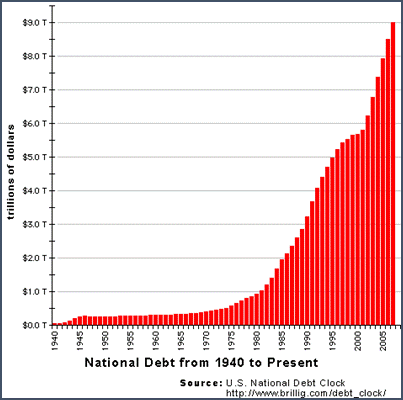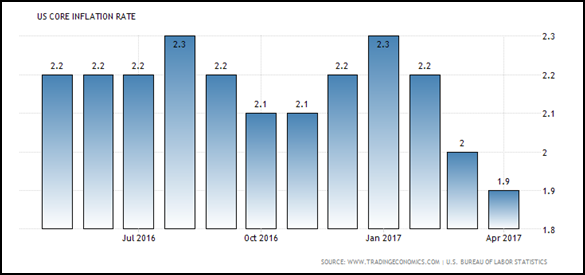Donald Trump, love him or hate him, has been anything but shy about laying out his political agenda, be it the repeal and replacement of Obamacare or the construction of a wall along the Mexican border.
One topic, however, has been noticeably absent, at least to me, from Trump’s political priorities. And that is tackling our monstrous national debt.
Can you think of the last time Trump talked about paying down our national debt? For that matter, have you heard about it from any Republican or Democrat?
In the past, Republicans wailed about the dangers of our debt bomb. But now that they have control of the White House, the Senate and the House of Representatives … they do nothing.
If anything, Trump is going to stomp on the national-debt gas pedal with all his proposed spending on infrastructure, tax reform, and defense.
We added more than a trillion dollars a year to the U.S. national debt during Obama’s eight years in the White House. And our debt binge accelerated toward the end of his second term. In fact, the national debt increased by more than 1.4 trillion dollars during fiscal 2016 (October to October)
The federal debt increased $1,422,827,047,452 and climbed to $19,573,444,713,936 on October 1, 2016. But it was stuck at $19.8 trillion before Congress came up with another temporary increase to the debt ceiling.
We will add another trillion to that number by the end of this year. And the Congressional Budget Office estimates that our national debt will reach $30 trillion within 10 years.
I know, it’s hard to fathom a number like $30 trillion. But here’s one way to look at it. If the government decided to give that $30 trillion back to us, every citizen in the U.S. would get around $93,000 each!
Ridiculous, I know, but I think that $30 trillion estimate will prove to be too low. Why so?
Last week, Eric Rosengren, president of the Boston Federal Reserve Bank, said to expect the return of Quantitative Easing or QE. “I think it is inevitable that we’re going to be talking about the balance sheet expanding during recession,” said Rosengren.
And James Bullard, president of the St. Louis Fed, said that QE is a “distinct possibility” the next time the economy hits a speed bump.
The purpose of Quantitative Easing was to keep longer-term interest rates low, and that is exactly what will happen again when the Fed rolls out a new round of QE.
Moreover, there is very little sign of any meaningful inflation to be found. The U.S Bureau of Labor Statistics reported the core consumer price index, or CPI numbers, last week and the April numbers came in lower than expected at a 1.9% annualized rate.
That was below Wall Street expectations and the first negative month-over-month since 2010.
Additionally, the University of Michigan’s survey of expected price changes over the next five to 10 years slipped to 2.3%, the lowest reading since the survey began in 1979.
Bonds rallied and long-term interest rates fell on that inflation news. But I expect long-term interest rates to keep falling. Remember, the Federal Reserve only controls short-term interest rates. Long-term interest rates are set by market forces.
To be fair, I want to disclose that my Calendar Profits Trader subscribers already own shares in iShares 20+ Year Treasury Bond ETF (TLT). So, they’re positioned to profit from it.
I’m not suggesting that you rush out and buy a bushel of long-term bonds tomorrow morning. As always, timing is everything. But I believe that long-term bonds will substantially outperform stocks for the rest of this year.
By a lot.
Grandchildren and Hong Kong
In June, I’m traveling to Seattle to visit my brother and sister and to attend the baby shower of my very first grandchild! My daughter, Keiko, will reveal the sex of her child at the June 10th baby shower, so I feel like a kid anxiously waiting for Christmas morning.
In mid-June, I fly to Hong Kong to find the next undiscovered home-run stock. Now that I am AARP-eligible, transoceanic travel takes a greater toll on my aging body. But these research trips are where I find my most profitable investment ideas.
Stay tuned!
Best wishes,
Tony Sagami



{ 4 comments }
16 May ’17.
Your commentary fails to disclose or ignores that the REAL debt of the USA is not just 18 trillions. You omitted the rest of it including federal pensions, social security and all the entitlements, which come up to my count of 224 trillions, not just 18!
I think you’re right about everything here … except the part about there being very little sign of inflation. Please … government CPI stats have lost their credibility with anyone who doesn’t massage their real cost of living with tricks like homeowner’s equivalent rent, hedonic adjustments, etc. The main purpose of such stats these days is to keep a lid on government obligations like SS COLAs and justify financial repression via ultra low interest rate policy.
I remember that the definition of core consumer price index was modified several years ago to switch the higher price increased item say beef with a lower price increased item say pork in the CPI because they are both meat. The net effect is to reduce the CPI number. Have you made this adjustment in the chart?
Bill and Chen are right on. The core consumer price index has always been manipulated by the feds to screw anyone whose retirement is depended on it; or to serve their interest.
I suppose, if transportation costs were included in the core index, we could all walk to work.
Thanks.